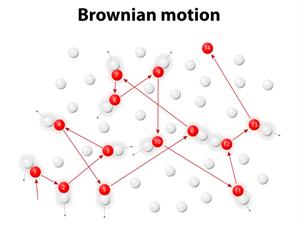PDF chapter test TRY NOW
Brownian motion or Brownian movement:
Brownian motion was named after Robert Brown, a Scottish botanist the first to explore such variations in \(1827\).
Brownian movement is any physical phenomenon in which a quantity is regularly subjected to minor, random variations.

Brownian movement
When colloidal fluid is studied under an advanced microscope, colloidal particles constantly can be seen moving in zig-zag directions.
The imbalanced bombardment of colloidal particles by the molecules of the dispersion medium causes Brownian movement. This movement is due to energy exchange or transfer between the particles.
Tyndall effect or Tyndall phenomenon:
The Tyndall effect is named after John Tyndall, a \(19th\) -century British scientist who pioneered research on it.

Tyndall effect
The Tyndall effect is caused by particles that are approximately the same size as the wavelength of light.

Passing of light through solution and colloid
According to Tyndall, when an intense beam of light is focused on a colloidal solution, the path of the beam becomes visible.
The illuminated route is known as the Tyndall cone, and the phenomenon is known as the Tyndall effect. In the case of a true solution, this phenomenon does not occur.

Tyndall cone
The scattering of a light beam by a medium containing microscopic suspended particles—for example, smoke or dust in a room makes a light beam entering a window visible.

Passage of light
Note:
The Tyndall effect is responsible for the beam of light emanating from vehicle headlights. Accordingly, the sky's blue colour is also attributable to Tyndall's effect.
